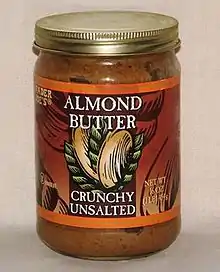Almond butter
Almond butter is a food paste made from grinding almonds into a nut butter. Almond butter may be "crunchy" or "smooth", and is generally "stir" (susceptible to oil separation) or "no-stir" (emulsified). Almond butter may be either raw or roasted, but this describes the almonds themselves, prior to grinding. It is recommended that almond butter be refrigerated once opened to prevent spoilage and oil separation.
 Trader Joe's store brand almond butter, classified as "crunchy" and "unsalted" | |
| Type | Spread |
|---|---|
| Main ingredients | Almonds |
Compared to peanut butter
Almond butter is an alternative to peanut butter for those with peanut allergies or who dislike the taste of peanuts. Almond butter contains significantly more fiber, calcium, potassium, iron, and manganese than peanut butter,[1] and about half the saturated fat,[2] although a slightly higher total fat content. Almonds, a type of tree nut, are not legumes, whereas peanuts are, so almond butter can be consumed by those looking to avoid legumes.
Nutrition
| Nutritional value per 100 g (3.5 oz) | |
|---|---|
| Energy | 2,648 kJ (633 kcal) |
21 g | |
| Dietary fiber | 3.7 g |
59 g | |
| Saturated | 5.6 g |
| Monounsaturated | 38.3 g |
| Polyunsaturated | 12.4 g |
15 g | |
| Minerals | Quantity %DV† |
| Zinc | 32% 3 mg |
| |
| †Percentages are roughly approximated using US recommendations for adults. Source: USDA FoodData Central | |
Almond butter is high in monounsaturated fats,[3] calcium, potassium, iron and manganese.[1] It is considered a good source of riboflavin, phosphorus, and copper,[1] and an excellent source of vitamin E,[4] magnesium, and fiber.[3] Almond butter also provides dietary protein.
See also
- List of almond dishes
- List of spreads
 Food portal
Food portal
References
- USDA.gov Archived 2011-10-22 at the Wayback Machine Sunflower Seed Butter and Almond Butter as Nutrient-Rich Alternatives to Peanut Butter
- Jenny Sugar. "Nutritional Comparison of Peanut Butter and Almond Butter". POPSUGAR Fitness. Archived from the original on 24 December 2013. Retrieved 18 September 2015.
- "Calories in Almonds - Nutrition and Health Facts". About.com. Archived from the original on 31 March 2014. Retrieved 18 September 2015.
- Vitamin E and Minerals: Eye Nutrition from Nuts Archived 2010-07-01 at the Wayback Machine - AllAboutVision.com
